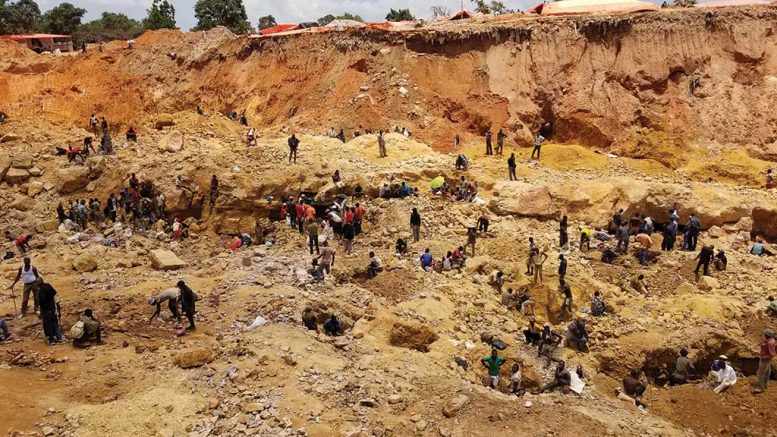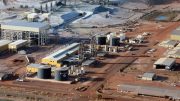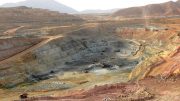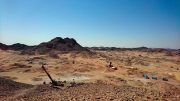Apart from the usual gold targets in West Africa and base metals in the Copperbelt, a couple of new trends in the junior exploration and development scene in Africa are more projects in East Africa and more juniors hunting for battery minerals. Here are examples of eight such juniors with active programs.
COBALT BLOCKCHAIN
Toronto-based junior Cobalt Blockchain (TSXV: COBC; US-OTC: COBCF) says it is focused on expanding its metal-trading business in the Democratic Republic of the Congo (DRC) to include conflict-free cobalt, copper, tin, tantalum and tungsten, via its existing trade platform; and building a portfolio of the same conflict-free mineral properties to address the growing global need for conflict-free cobalt in technological applications, such as for batteries in electric vehicles.
The company notes that 10% of the world’s cobalt supply is produced by artisanal miners in the DRC, where there have been concerns due to issues such as child labour. But Cobalt Blockchain says it has “extensive experience in impact-focused certification to ensure socially responsible mining, primarily for commodity trading in tin, tantalum and tungsten, and intends to translate this experience into the provisioning of conflict-free cobalt and other metals.”
For enhanced access to client supply chains, the firm will deploy a blockchain-based certification protocol on its own cobalt and 3T operations, and possibly use the protocol for other operations that need conflict-free assurance, such as for diamonds and gold.
In June, Cobalt Blockchain signed a letter of intent for a US$10-million, revolving trade-finance facility with United Bank for Africa. The funds are to be directed to buying cobalt concentrates from a DRC mining cooperative in an agreement that guarantees Cobalt Blockchain a supply of cobalt concentrate of 40,000 tonnes per annum.
DESERT LION ENERGY
Toronto-based, Tim Johnston-led Desert Lion Energy (TSXV: DLI; US-OTC: DSLEF) is developing the first large-scale lithium mine in Namibia, located near Karibib in the Erongo region, within 301 sq. km of prospective land with known lithium-bearing pegmatitic mineralization.
Desert Lion says the brownfield lithium asset was found and developed in the 1930s, and the property has a history of small-scale mining operations, including the historic Rubicon and Helikon lithium mines.
The company notes the project site is accessible year-round by road with access to power, water, rail, port, airport, and communication infrastructure.
Desert Lion is in the first phase of its production plan: producing and exporting lithium concentrate from stockpiled material.
In May, the company determined it would cost $7 million to build a flotation plant capable of processing between 350,000 tonnes and 400,000 tonnes of feed per year.
The company looks to prove up a resource in an initial range of 10 million to 15 million tonnes grading 1.5% Li2O.
EAST AFRICA METALS
Vancouver-based East Africa Metals (TSXV: EAM; US-OTC: EFRMF) looks to explore and develop mineral projects in East Africa.
Its principal assets and interests include the 70%-owned Harvest polymetallic, volcanogenic massive sulphide project and the wholly owned Adyabo gold project, with both projects located 600 km northwest of Addis Ababa in Ethiopia.
The company says it has tabled a positive preliminary economic assessment for the Terakimti heap-leach gold project at Harvest and the Mato Bula gold-copper and Da Tambuk gold projects at Adyabo.
The company has received approval for a mining licence at Harvest, and is under application for two mining licences at Adyabo.
East Africa Metals also owns and is advancing the 93 sq. km Handeni gold property in northeastern Tanzania, with the property also hosting the Magambazi gold deposit discovered in 2009.
M2 COBALT
M2 Cobalt (TSXV: MC; US-OTC: MCCBF) is focused on discovering and developing world-class cobalt assets in Uganda, and to that end has accumulated 100% ownership in claims covering 1,600 sq. km of prospective land in the country.
Noting that Uganda borders the DRC, which produces 65% of the world’s cobalt, M2 Cobalt states that its assets “share the same underlying geology, and are on trend with a number of major producing mines in the DRC, Rwanda and Tanzania.” It says some of its key assets are “close to, and on trend with, the former producing Kilembe mine, which between the 1950s and 1970s was Uganda’s largest producing copper-cobalt mine, and which produced some of the highest grades of copper globally during that time.”
In mid-June, M2 Cobalt identified new, high-priority anomalies after the completion of four Geotech, helicopter-borne, VTEM B-Field horizontal magnetic gradiometer geophysical surveys at its Kilembe-area properties and at the Waragi and Bombo targets at its Bujagali property.
MAYA GOLD & SILVER
Don’t be thrown by the “Maya” in its name — Montreal-based, Noureddine Mokaddem-led Maya Gold & Silver (TSXV: MYA; US-OTC: MYAGF) is a trailblazer in developing gold and silver projects in Morocco’s relatively under-developed mining industry.
Maya’s flagship asset is its Zgounder silver mine, which is co-owned by Maya (85%) and l’Office National des Hydrocarbures et des Mines of the Kingdom of Morocco (15%).
During the first quarter of 2018, Zgounder produced 69,578 oz. silver, generating revenue from silver of $2.1 million, versus $3.6 million for the year-ago quarter.
In February, Maya filed a technical report on a positive preliminary economic assessment for a new mine at Zgounder, where $2.4 million was spent on development in the first quarter.
In April, Maya raised $28.3 million at a 32% premium to the market price of its shares to accelerate building the new mine at Zgounder.
In the coming months, Maya will commission flotation cells and expects to see production increase to 500 tonnes per day, and to declare commercial production.
NEXUS GOLD
Vancouver-based Nexus Gold (TSXV: NXS; US-OTC: NXXGF) is developing multiple gold projects in Burkina Faso, including the 178 sq. km Niangouela gold concession on the Boromo greenstone belt; the 39 sq. km Bouboulou gold concession (previously explored by Riverstone Resources and Roxgold); and the 250 sq. km Rakounga gold concession, which is contiguous to Bouboulou.
In two steps over the past two months, Nexus chairman and chief operating officer Alex Klenman was appointed president and CEO, replacing Peter Berdusco, who has stayed on as a director. Geologist Warren Robb was also named senior vice-president of exploration.
J. Ian Stalker joined the Nexus board in May, taking the seat held by Michael Kinley, who later resigned as chief financial officer.
In June, Zula Kropivnitski was appointed chief financial office of Nexus.
In June, Nexus kicked off a 105-line-kilometre geochemical survey on the Rakounga permit in central Burkina Faso, having closed a $3-million financing in May that saw Sandstorm Gold (TSX: SSL) take a 17.3% interest in Nexus.
ROXGOLD
Toronto-based Roxgold (TSX: ROXG; US-OTC: ROGFF) is a gold-mining company that owns the high-grade Yaramoko gold mine in Burkina Faso’s Houndé greenstone region.
For the first quarter of 2018, Roxgold produced a record 40,452 oz. gold at an all-in sustaining cost of US$658 per oz. sold. That generated cash flow from mining operations during the quarter of US$30.9 million, or US8¢ per share.
First-quarter earnings were US$13.9 million, up from US$3.8 million in the year-ago quarter.
Roxgold has increased its guidance for all of 2018 to 120,000 to 130,000 oz. gold, up from the previous guidance of 110,000 to 120,000 oz. gold.
Roxgold also reported it has received approval to develop its Bagassi South expansion project on the Yaramoko property, with recent work including excavating a boxcut to the second level and ordering underground mobile equipment.
In May, Roxgold chief operating officer Paul Criddle announced he would retire in July, with Iain Cox to step in first as interim chief operating officer.
TERANGA GOLD
Teranga Gold (TSX: TGZ; US-OTC: TGCDF) has a lot of irons in the fire with production- and development-stage gold assets in several West African countries, as well as exploration assets covering 6,400 sq. km in Burkina Faso, Senegal and Côte d’Ivoire.

Teranga Gold’s Sabodala gold mine in Senegal. Credit: Teranga Gold.
Teranga notes that since its initial public offering in 2010, it has produced more than 1.4 million oz. gold from its operations in Senegal, which as of June 2017 had 2.7 million oz. gold in reserves.
In September 2017, the company released a positive feasibility study for its Wahgnion gold project in Burkina Faso.
But more recently, based on drill results from a 73,000-metre infill drill program finished in 2017, Teranga has updated the combined measured and indicated resource at Wahgnion to 50.5 million tonnes at 1.51 grams gold per tonne for 2.4 million contained oz. gold — or a third higher than in the 2017 feasibility study.
Teranga expects to release an updated reserve estimate and related technical report for Wahgnion before September.
Teranga says it has a “strong balance sheet and the financial flexibility to execute on its growth strategy,” and can boast nearly 4 million oz. gold in reserves from its combined Sabodala gold operations and Wahgnion gold project.






Be the first to comment on "Africa Snapshot: Eight juniors on the hunt for precious metals, battery minerals"